Reciprocating saws are one of the most useful tools in the gardener’s toolbox, but they’re often forgotten. We’re too quick to jump to detail and think of the garden as a place for quick fixes, but when you find old pipework, timber foundations, or pipe and wire sheathing that needs removing, there’s no tool more capable than a reciprocating saw.
In this guide we’re going to talk about the situations where you need one, and how to choose the best reciprocating saw for you, so whether you’re new to this handy power tool, or you’re looking for a new model, this is the guide for you.
More...
Top Pick


Best Value


Premium Choice

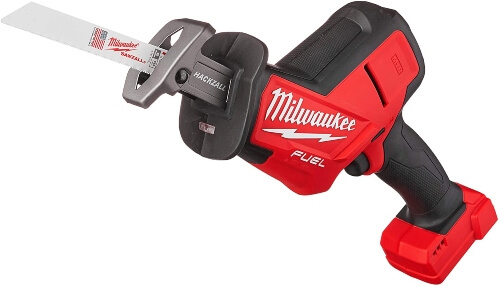
Best Reciprocating Saws for 2025
Product | Our Rating | Price | |
|---|---|---|---|
1. Worx WX500.9 Cordless Reciprocating Saw |  | ||
2. Black + Decker Corded Reciprocating Saw |  | ||
3. Milwaukee M18 Fuel Hackzall |  |  | |
4. Makita DJR186 18V Reciprocating Saw | |||
5. Ryobi One+ 18V Reciprocating Saw | |||
6. DeWalt 20V Max XR Compact Reciprocating Saw | |||
7. Black + Decker Battery Reciprocating Saw | |||
8. Ingersoll-Rand Pneumatic Air Reciprocating Saw | |||
9. Bosch Cordless Reciprocating Saw |
Reciprocating Saws Buyer’s Guide
What is a Reciprocating Saw?
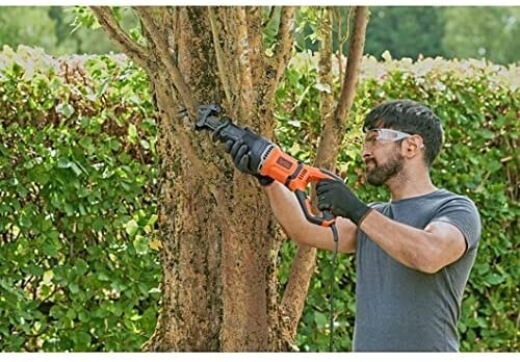
Reciprocating saws, or recip saws for short, are compact power tools capable of cutting through timber, metal and plastic in small spaces where it would usually be impossible to fit a hand saw, or a circular saw.
While these saws include jigsaws, when we talk about them more generally we mean the sturdier saws for heavy-duty work, while jigsaws are less powerful saws for cutting detail and curves quickly and neatly.
Standard reciprocating saws are all about power, speed, and getting the job done without any flair, detail or finesse.
Let us talk about how to use reciprocating saws, and how to stay safe too, but more importantly, I want to start with the differences between it's different types, and what to look for when buying one too.
When do you need a Reciprocating Saw?
Reciprocating saws are excellent tools for pruning, making light work of small branches and shrubs for spring, summer or winter pruning (you might want something more powerful like a chainsaw for the mature timber on deciduous trees in autumn though).
As well as pruning though, these saws can be used in the garden just as you would in the home or on a construction site – they’re great tools for cutting pipework and timber and quickly removing obstacles that a hand saw wouldn’t be able to reach.
Different Types of Reciprocating Saw

Cordless Reciprocating Saw
This type is the most commonly sold type out there, but they pack less of a punch than corded or pneumatic reciprocating saws.
They’re great tools for DIYers and gardeners though as they generally have a lower price tag, and fit the same batteries as the rest of your toolbox which makes them easier to store.
The biggest benefit of cordless and battery reciprocating saws is that they’re lightweight and more comfortable to use. The lighter design and smaller motors make them better for general use, but also means they have less power and a limited run time, which can limit bigger jobs.
Corded Reciprocating Saw
Corded reciprocating saws are more powerful than battery-powered saws, and run slightly faster with a small difference of 290 RPM to 3000 RPM. The biggest benefit of corded recip saws is really convenience; giving you the ability to just plug and cut, unlike battery tools that are unusable when you forget to charge them.
Air Reciprocating Saw (Pneumatic Reciprocating Saw)
Air reciprocating saws, or pneumatic reciprocating saws, are the most powerful type, but they come with a lot of added extras. Most importantly you’ll need an air compressor to power them, and a portable generator or main source to power the compressor.
Pneumatic tools are really only intended for professional use and make more efficient use of generator fuel by creating compressed gas that powers multiple tools rather than just supplying each tool as and when needed.


Get Your Free Guide:
Master Growing Australian Natives eBook
A Must Have Complete Guide for Every Australian Garden
Get Your Free Guide:
Master Growing Australian Natives eBook
A Must Have Complete Guide for Every Australian Garden
What to Look For When Buying a Reciprocating Saw
When you’re looking for a reciprocating saw, there’s only really one consideration; cutting ability. Because these tools are completely dependent on the friction of the materials they cut it’s hard to use their specifications to give an accurate guide to what they can and can’t cut, but consider the guide below to help understand their power.
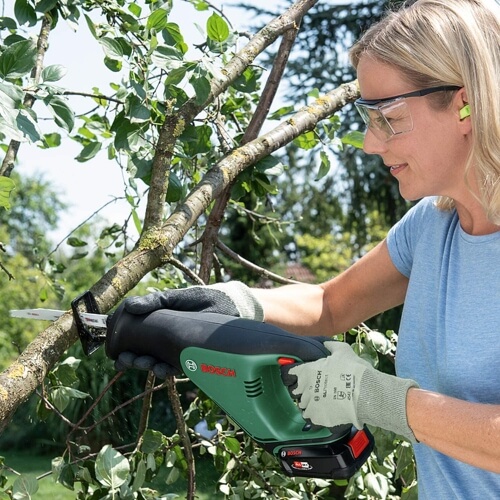
How powerful should a reciprocating saw be?
This tool should run at a minimum of 2000 rpm, but it’s quite rare to find any below that these days, with 90%of even the cheapest battery-operated tools running at 2600 rpm or more. But don’t confuse RPM with power.
The rpm of a recip saw gives you a good guide to how fast it can cut simple materials with minimal friction, but it’s really all about the inner workings, so rather than giving horsepower, or relative voltages, most manufacturers just give guides to what it can and can’t cut.
For example, a type that says it cuts through steel (no matter how thick) is a winner, but if it's best claim is cutting through pine, then check what else is in that price range.
How to Use a Reciprocating Saw
Reciprocating saws are incredibly easy to use, and in most cases, the material you’ll be cutting will be static and held in place already, so there’s usually no need to clamp anything down.
The only thing that can really go wrong when you first use your new recip saw is changing the blade.
How to Install the Blade on a Reciprocating Saw
- Unplug the cord or remove the battery to prevent any accidents.
- Press the chuck lock, or twist the chuck (either by hand or using a hex key) into the open position.
- Fully insert the saw blade, with the cutting edge facing away from you.
- Tighten the chuck.
- Done.
Reciprocating Saws Safety Guidance

Reciprocating saws are like any power tool in that they can misfire, misbehave and are very much reliant on the materials they are working with to operate properly, and like any saw, they do not like coming across nails or screws, or bits of metal halfway through a cut in timber.
Top safety tips for using a reciprocating saw:
- Wear safety goggles (you never know what might fly up)
- Use a sharp blade (each blade should be changed every year as a minimum)
- Keep hands away from the blade.
- Hold the tool with both hands (This tool are used on secured materials)
- Always keep the cable behind the blade.
- Never use the saw blade near flammable materials (the sparks can cause ignitions)
Reciprocating Saw Reviews
1. Worx WX500.9 Cordless Reciprocating Saw

For anyone with a set of Worx tools already, this saw uses the same battery and charging points to save space and time in the garage, but that’s in no way its best feature.
At 3000 rpm the Worx reciprocating saw is the most powerful battery-powered type on review here, and thanks to its rear handle, it's super comfortable to use in the garden and on the move.
Different gardeners will have their own opinions here, but for me, I much prefer tools with rear handles. They’re safer because you’re further from the blade, but also, your pressure is more even on the blade so I always feel much more in control of the tool when I’ve got an even pressure and can feel the tool at work.
Pros
Cons
2. Black + Decker Corded Reciprocating Saw

The Black + Decker corded reciprocating saw is, as you might expect, more powerful than their battery-powered option, and means you don’t need to buy a battery pack and charger set too, so save money at the same time.
What I really love about this recip saw from Black + Decker is the branch gripper, which helps maintain control when cutting through timber in the garden that might sway with the wind, or move as you cut it, allowing you to exert pressure without bending the blade.
Pros
Cons
3. Milwaukee M18 Fuel Hackzall

Milwaukee’s Hackzall range is a departure from traditional reciprocating saws in design, ergonomics and power. When I first found out that Milwaukee made their reciprocating saws to different specs than most manufacturers my first thought was “can I use any blade with a Hackzall?” and thankfully; yes.
You can use any universal reciprocating saw blade with a Milwaukee Hackzall, so if you want to do things a little differently and have a simpler tool to handle, change and power, then it’s definitely worth considering a Hackzall.
Pros
Cons
4. Makita DJR186 18V Reciprocating Saw
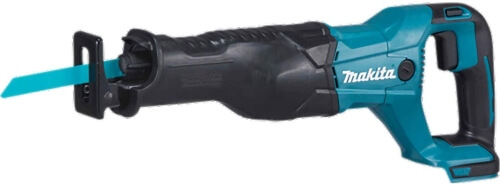
The Makita reciprocating saw is a really powerful tool, but it’s heavier than its competition so slightly less comfortable to use. Its rear handle makes it incredibly easy to control though, and the wright adds ballast too which can be a benefit in some ways.
While it’s technically less powerful than most comparable models at 2800 rpm, it’s got a better drive and is more capable of coping with the friction against tough materials.
So the Makita might not be the fastest or lightest, but it’s possibly the toughest battery reciprocating saw on test.
Pros
Cons
5. Ryobi One+ 18V Reciprocating Saw

The Ryobi Reciprocating Saw is part of the standard Ryobi One+ range, meaning it works with the same battery as most of your other Ryobi tools.
It’s a little bit flimsy though, and there are better ones for a lower price, but where Ryobi comes into its own is with existing Ryobi owners.
There are very few recip saws that come with batteries, and as most are more obscure brands, buying Ryobi ensures you’re more likely to find tools that match the battery in future, rather than regularly relying on new batteries.
Pros
Cons
6. DeWalt 20V Max XR Compact Reciprocating Saw
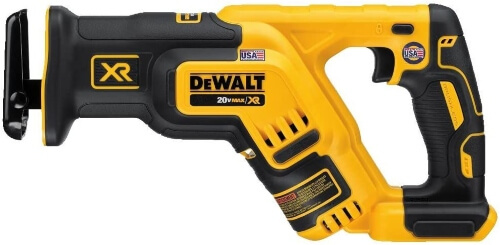
The DeWalt Reciprocating Saw is a great tool for standard use, especially for DIYers, with a straightforward and intuitive blade change mechanism for secure and easy blade fittings in four directions so you can reach harder to reach places.
The choice with the DeWalt is really about comfort, because it’s 100% a good tool, with more uses than most recip saws, and a better range of cutting angles that reach difficult spaces, but with no vibration control, and an uncomfortable handle.
Pros
Cons
7. Black + Decker Battery Reciprocating Saw
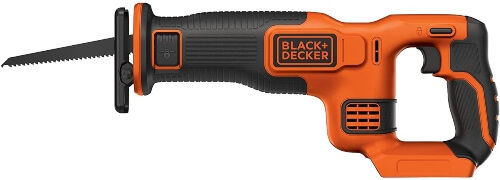
Black + Decker used to make incredible tools for everyone, but their products are aimed squarely at DIYers on a budget these days, which in some ways means their tools aren’t as durable anymore, but it also means they’re affordable, and get the job done, which is sometimes all you need.
I’m not going to tell you that this is an incredible tool, because it’s an average reciprocating saw, but a really great budget option, with the added benefit of a pivoting blade shoe that gives better purchase on curved objects.
Thanks to the pivoting shoe it’s perfect for branches and garden work on uneven materials too.
Pros
Cons
8. Ingersoll-Rand Pneumatic Air Reciprocating Saw

Air-powered reciprocating saws have one really huge benefit; they’re smaller. Because they don’t need a motor and work entirely off pressurised pneumatics, they deliver powerful cuts without taking up space so these pneumatic recip saws fit into the tightest possible spaces for accurate and efficient cutting.
If you’re ever looking for a good brand for pneumatic tools, Ingersoll-Rand makes beautiful, well-built tools that last, and while they’re more expensive than battery-operated tools, they pack a bigger punch and are really the only choice for serious contractors.
Pros
Cons
9. Bosch Cordless Reciprocating Saw
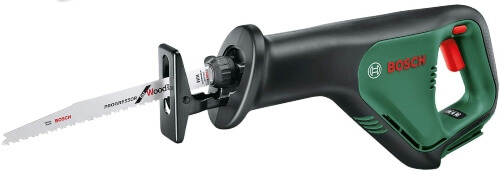
The Bosch Reciprocating saw is really designed for DIY as a quick go-to saw for small jobs, but it’s surprisingly good at handling tougher tasks too, including pipe work, and most timber, but because of its shorter stature is less happy with longer blades than some other types you can buy for around the same price.
The biggest benefit of the Bosch is that it’s really neat and compact, so is great for toolboxes and doesn’t take up loads of space with its own storage container so it’s a great choice for practical gardeners with a tidy garage to maintain.
Pros
Cons
Best Reciprocating Saws Australia
Reciprocating Saw - Our Top Pick


I’m struggling to find anything bad to say about the Worx Reciprocating saw, other than the fact it doesn’t come with the battery included, but that’s standard across almost every recip saw these days, so is barely even a negative.
The Worx recip saw is such an efficient tool, with an incredibly comfortable grip, and long battery life that you’ll barely even realise you’re not using a corded tool, and it’s such good value too.
If I was going to head out and buy myself a new one today, it would, without a doubt, be the Worx WX500.9 Cordless Reciprocating Saw
Best Value Reciprocating Saw


We usually wouldn’t recommend Black + Decker these days in a Top Picks section, but sometimes it’s worth letting go of your preconceptions and just seeing how the tool actually works.
Black + Decker Corded Reciprocating Saw is a genuinely good one from Black + Decker for around half the price of any comparable corded reciprocating saw.
The neat addition of the branch grippers is a great indication of a well-considered and purpose-built tool, where the manufacturers have considered the most likely use, and built it to work for that and that alone.
The Black + Decker corded reciprocating saw is the best for gardeners by a long way.
Premium Choice Reciprocating Saw


Milwaukee are so confident with their reciprocating saws that they don’t even call them reciprocating saws. Milwaukee Hackzalls are always going to be the top end of recip saws, so it’s no surprise that the Milwaukee M18 Fuel Hackzall comes out as our premium recip saw.
With an easy to use ergonomic grip, safe trigger, and easy to change the blade with a lot of power behind it, it’s the obvious choice for anyone looking for a professional quality recip saw.
Reciprocating Saws Frequently Asked Questions
What can a reciprocating saw cut?
Reciprocating saws can cut prepared timber, raw branches, metal, plastic, soft breeze block, and even hardened nails. Of all the tools in your shed that you probably under-use, reciprocating saws are almost definitely the most overlooked.
Can I use a reciprocating saw to cut wood?
Reciprocating saws can cut through metal, timber, plaster, fibreglass, plastics, composites and even masonry with the right blade. Always use the right blade for whatever material you are cutting, and make sure to clear any fittings from timber before using a reciprocating saw.
Can a reciprocating saw cut steel?
Reciprocating saws can cut steel, aluminium, copper, and even cast iron. The thickness of the material will differ depending on the saw, but most modern reciprocating saws can handle solid steel bars up to 9/16 inches thick.
Can a reciprocating saw cut meat?
Reciprocating saws are handy for more than just cutting through timber, metal, and plastic pipe. Reciprocating saws can also cut frozen meat, and make light work of simple butchery.
However, be sure to clean your tools properly and thoroughly afterward as any residue can clog the blade.
Can you use any blades for reciprocating saws?
Reciprocating saws have universal shanks, so other than very fine models, you can use any blade with your reciprocating saw. One tool can be used for timber, plastic, or metal, and keeping a good supply of universal blades on hand means you’ll always be ready to work.
How big of a branch can a reciprocating saw cut?
Reciprocating saws can cut a greater thickness of wood than metal. Some saw blades are capable of cutting branches up to 8 inches thick. Personally, I’d advise using a chain saw as sap from tree branches can be a struggle for reciprocating saws.
How thick of metal can a reciprocating saw cut?
Reciprocating saws can cut metal up to 9/16 of an inch thick. That’s ideal for steel bars, and metal joists, but make sure you’ve got the right blade attached. Different saw blades are capable of greater thicknesses than this, but be sure to keep your cut straight so as not to warp the blade.
Are reciprocating saw blades universal?
All reciprocating saw blades have a universal shank so they will work with any reciprocating saw. Every blade is designed for a different purpose, whether it's hardwood or softwood, or metal or masonry, there are blades for every material, and each one should fit any model by any brand.
Why is it called a reciprocating saw?
Reciprocating saws are given their name due to their backward and forward motion, pulsing the blade up and down between two points (i.e. reciprocal).
While most share the same name, the brand Milwaukee began selling theirs under the trademarked Sawzall.
Can you cut 4x4 with a reciprocating saw?
You can cut whatever width of timber the blade will allow with a reciprocating saw. These tools are designed to be universal and cut through anything, so provided you cut straight and have the right blade installed your recip saw will easily cut through 4x4.
For more cutting tools, check out our buying guide and product reviews:

Get the Best Reciprocating Saw Today
Next time you find yourself out in the garden, cutting back overgrown shrubs with a hacksaw, don’t blame us! We absolutely recommend battery recip saws as the best ones for gardeners, with the durability for most jobs, and a great affordable choice for the average DIY toolbox.
Reciprocating saws are a must-have tool for gardeners and DIYers who hate wasting time on projects that can speed up with better tools. But, if you’re reading this, I guess you already knew that.
Hopefully, the above saws fit the bill for you and you’ll have the best reciprocating saw for your next project on its way soon.
Published on December 23, 2022 by Gary Clarke
Last Updated on December 27, 2025




